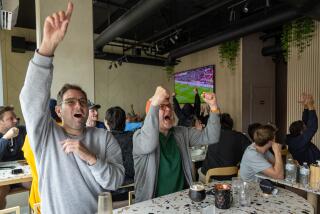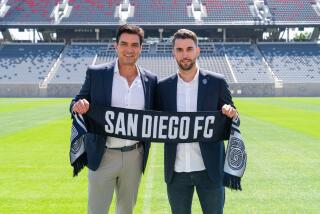Soccer League Puts Its Best Foot Forward
The fields that gave birth to baseball greats Darryl Strawberry and Ozzie Smith are now home to a generation with a new love: soccer.
More than 400 children from South-Central Los Angeles play at the Harvard Recreation Center as part of the American Youth Soccer Organization’s Region 1031. Many do so with the help of leagues in more affluent areas.
The organization’s philosophy is “everyone plays,”--every child must play for at least half the game, said David Hauptman. The Culver City resident has worked with AYSO for almost 30 years. Since most AYSO leagues charge more than $50 per child, however, “It isn’t really ‘everyone plays,’” he said. “It’s ‘everyone who’s middle class plays.’”
But as South-Central’s population has changed from predominantly African American to largely Latino, demand for baseball has decreased, making soccer the sport of choice, said Cleve Freeman--co-founder, with Hauptman, of Region 1031. Together, they have adapted AYSO’s suburban model of coaching and organizing to fit the needs of South-Central’s emerging immigrant communities.
Region 1031 charges youngsters $15 to join, $11 of which goes toward insurance. The amount is low enough to allow large families to enroll four, five, even six children. And 20% to 30% of the players--basically anyone who asks--get scholarships.
It’s hard to ask parents to pay the fees when they’re struggling to make ends meet. Once, “kids passed out on the field for lack of food,” Freeman said.
The program survives on contributions. Wealthier leagues, which charge $80 to $1,000 to play, collect their used uniforms for the South-Central league. Referees donate their time. Corporate sponsors pay tournament fees and provide equipment.
Freeman, a reserve officer in the Los Angeles Police Department’s 77th Division, knew nothing about soccer when he started the league seven years ago. The Hyde Park resident began recruiting players at the request of a police captain, who saw youngsters playing the sport in the street and wondered why no leagues existed for them.
Freeman remembers clearly how his soccer education with Hauptman began at team registration day. At the time Freeman had a ball under his arm.
“Drop the ball,” Hauptman said. “And get out of the way.”
That first year, 120 children played on eight teams. The LAPD provided some officers to coach and referee initially. The league now averages 45 teams of girls and boys.
At a Saturday practice, children ages 4 to 19 practiced drills on every available inch of Harvard Recreation Center’s four baseball diamonds and mottled grass. Vendors with bicycle carts sold corn on the cob and bags of Cheetos. Parents shouted advice. “Buscalo, hijo!” Get it, son!
Many of the youngsters wore black soccer socks with white edges--the style formerly worn by referees. But when regulations changed the referees’ uniforms to a black sock with three white stripes, Region 1031 players got the old-style socks.
Region 1031 is not the only group offering soccer in a poor area of the county. But through the donations that keep it going, and games with other regions, it links South-Central’s Latino community with other parts of Los Angeles.
“Obviously the Hispanic community is our biggest opportunity to increase our membership,” said Vince Mirabella, executive director of California Youth Soccer Assn.-South, a major youth league.
“They were born playing soccer,” said Viviana Quinones, 17, a player and coach.
About 245,000 Southern California children play in AYSO, which depends on volunteers for day-to-day operation of its leagues. In South-Central, that’s a luxury.
“They’re blue-collar workers,” said Tom Rios, development manager in AYSO’s national offices of the South-Central parents. “They don’t have as much time available” to volunteer on a soccer league. But older players pitch in when adults aren’t available.
Santo Gutierrez and his wife, Delia, are among the parents who somehow find time to serve as coaches. Although Region 1031 is modest compared to other AYSO regions, it’s quite an improvement over what Santo remembers growing up in El Salvador.
“At least they can afford to buy balls,” he said of Region 1031, recalling how he and other boys in El Salvador would take a collection to raise 25 cents to buy a plastic ball.
The presence of Delia Gutierrez and other female coaches, as well as girls teams, may be common elsewhere, but is a novelty for some immigrant Latinos.
“In the culture of that community, girls don’t play soccer,” Freeman said. “Then we had another challenge--parents didn’t want men coaching their girls.”
Some don’t like women like Agripina Hernandez coaching boys, either. “It’s hard for women to coach,” she said. “Men don’t always listen to women. For them it’s hard to see a woman coach boys.”
The single mother sometimes crams her five children, ages four through 17, into her tiny car to get them to practices. To earn her coaching certificate Hernandez spent hours at workshops and researched materials at the Amateur Athletic Assn.’s sports library on Adams Boulevard, taking time away from her courses at East Los Angeles College.
Hernandez didn’t play sports as a child. “My parents were very strict, since we were five girls and one boy,” she said during a recent game. For her own two daughters, however, “if they enjoy it, I’m there to support.” As she spoke, a 12-year-old goalie blocked a shot. “All right, Simon!” she shouted. “That’s my son!”
For the future, the region will focus on grants and corporate sponsorships to keep growing. A grant in 2000 from the Amateur Athletic Foundation enabled it to waive the registration fees for girls, bringing more than 200 into the league. More sponsorships will allow the region to take a major step next season: Not only will all youngsters in Region 1031 play, they’ll play for free.






